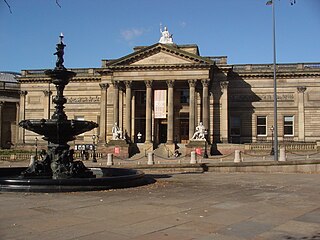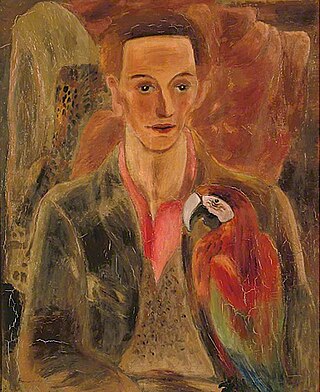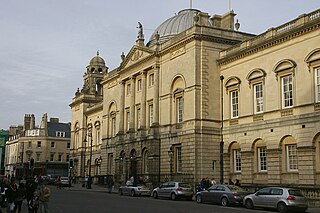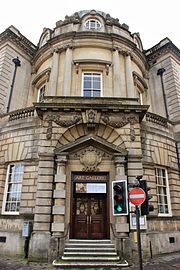
The National is the national art gallery of Scotland. It is located on The Mound in central Edinburgh, close to Princes Street. The building was designed in a neoclassical style by William Henry Playfair, and first opened to the public in 1859.

The Victoria and Albert Museum in London is the world's largest museum of applied arts, decorative arts and design, housing a permanent collection of over 2.27 million objects. It was founded in 1852 and named after Queen Victoria and Prince Albert.

Suzanne Valadon was a French painter who was born Marie-Clémentine Valadon at Bessines-sur-Gartempe, Haute-Vienne, France. In 1894, Valadon became the first woman painter admitted to the Société Nationale des Beaux-Arts. She was also the mother of painter Maurice Utrillo.

The National Gallery of Australia (NGA), formerly the Australian National Gallery, is the national art museum of Australia as well as one of the largest art museums in Australia, holding more than 166,000 works of art. Located in Canberra in the Australian Capital Territory, it was established in 1967 by the Australian Government as a national public art museum. As of 2022 it is under the directorship of Nick Mitzevich.

Birmingham Museum and Art Gallery (BM&AG) is a museum and art gallery in Birmingham, England. It has a collection of international importance covering fine art, ceramics, metalwork, jewellery, natural history, archaeology, ethnography, local history and industrial history.

The Walker Art Gallery is an art gallery in Liverpool, which houses one of the largest art collections in England outside London. It is part of the National Museums Liverpool group.

The Royal Scottish Academy building, the home of the Royal Scottish Academy, is an art museum in Edinburgh, Scotland. It is situated at the junction of The Mound and Princes Street in the centre of the city. It was built by William Henry Playfair in 1822-6. Along with the adjacent National Gallery of Scotland, their neo-classical design helped to transform Edinburgh into the cityscape known as "the Athens of the North". Today the structure is a Category A listed building.

The Vienna Secession is an art movement, closely related to Art Nouveau, that was formed in 1897 by a group of Austrian painters, graphic artists, sculptors and architects, including Josef Hoffman, Koloman Moser, Otto Wagner and Gustav Klimt. They resigned from the Association of Austrian Artists in protest against its support for more traditional artistic styles. Their most influential architectural work was the Secession exhibitions hall designed by Joseph Maria Olbrich as a venue for expositions of the group. Their official magazine was called Ver Sacrum, which published highly stylised and influential works of graphic art. In 1905 the group itself split, when some of the most prominent members, including Klimt, Wagner, and Hoffmann, resigned in a dispute over priorities, but it continued to function, and still functions today, from its headquarters in the Secession Building. In its current form, the Secession exhibition gallery is independently led and managed by artists.

Auckland Art Gallery Toi o Tāmaki is the principal public gallery in Auckland, New Zealand. It has the most extensive collection of national and international art in New Zealand and frequently hosts travelling international exhibitions.

The Dunedin Public Art Gallery holds the main public art collection of the city of Dunedin, New Zealand. Located in The Octagon in the heart of the city, it is close to the city's public library, Dunedin Town Hall, and other facilities such as the Regent Theatre.

Dame Ethel Walker was a Scottish painter of portraits, flower-pieces, sea-pieces and decorative compositions. From 1936, Walker was a member of The London Group. Her work displays the influence of Impressionism, Puvis de Chavannes, Gauguin and Asian art. Walker achieved considerable success throughout her career, becoming the first female member elected to the New English Art Club in 1900. Walker's works were exhibited widely during her lifetime, at the Royal Academy, the Royal Society of Arts and at the Lefevre Gallery. She represented Britain at the Venice Biennale four times, in 1922, 1924, 1928 and 1930. Although Walker proclaimed that 'there is no such thing as a woman artist. There are only two kinds of artist — bad and good', she was elected Honorary President of the Women's International Art Club in 1932. Soon after her death, she was the subject of a major retrospective at the Tate in 1951 alongside Gwen John and Frances Hodgkins. Walker is now acknowledged as a lesbian artist, a fact which critics have noted is boldly apparent in her preference for women sitters and female nudes. It has been suggested that Walker was one of the earliest lesbian artists to explore her sexuality openly in her works. While Walker was contemporarily regarded as one of the foremost British women artists, her influence diminished after her death, perhaps due in part to her celebration of female sexuality. Made a Dame Commander of the Order of the British Empire in 1943, Walker was one of only four women artists to receive the honour as of 2010.

Sir Cedric Lockwood Morris, 9th Baronet was a British artist, art teacher and plantsman. He was born in Swansea in South Wales, but worked mainly in East Anglia. As an artist he is best known for his portraits, flower paintings and landscapes.

The Harris Museum is a Grade I-listed building in Preston, Lancashire, England. Founded by Edmund Harris in 1877, it is a local history and fine art museum.

The Storey, formerly the Storey Institute, is a multi-purpose building located at the corner of Meeting House Lane and Castle Hill in Lancaster, Lancashire, England. Its main part is recorded in the National Heritage List for England as a designated Grade II listed building, with its back entrance being listed separately, also at Grade II.

Tate Britain, known from 1897 to 1932 as the National Gallery of British Art and from 1932 to 2000 as the Tate Gallery, is an art museum on Millbank in the City of Westminster in London, England. It is part of the Tate network of galleries in England, with Tate Modern, Tate Liverpool and Tate St Ives. It houses a substantial collection of the art of the United Kingdom since Tudor times, and in particular has large holdings of the works of J. M. W. Turner, who bequeathed all his own collection to the nation. It is one of the largest museums in the country. The museum had 525,144 visitors in 2021, an increase of 34 percent from 2020 but still well below pre- COVID-19 pandemic levels. In 2021 it ranked 50th on the list of most-visited art museums in the world.

Guildhall is an 18th-century municipal building in central Bath, Somerset, England. It is a Grade I listed building.

The Montmartre paintings are a group of works that Vincent van Gogh created in 1886 and 1887 of the Paris district of Montmartre while living there, at 54 Rue Lepic, with his brother Theo. Rather than capture urban settings in Paris, van Gogh preferred pastoral scenes, such as Montmartre and Asnières in the northwest suburbs. Of the two years in Paris, the work from 1886 often has the dark, somber tones of his early works from the Netherlands and Brussels. By the spring of 1887, van Gogh embraced use of color and light and created his own brushstroke techniques based upon Impressionism and Pointillism. The works in the series provide examples of his work during that period of time and the progression he made as an artist.

The Main Library, also known as the Erie Public Library, combines elements of the Beaux Arts Classicism and Second Renaissance Revival styles of architecture. Both were commonly used at the end of the nineteenth century to convey the importance of public buildings. The building features arched openings, a prominent cornice, swag and garland decorations, and a roofline balustrade. It is clad in Pompeian red brick. The original facade is dominated by a marble portico, which was removed and stored by previous owners. It was reassembled and conserved as part of the renovation, recapturing the library's original grandeur.

The Petit Luxembourg is a French hôtel particulier and the residence of the president of the French Senate. It is located at 17–17 bis, rue de Vaugirard, just west of the Luxembourg Palace, which serves as the seat of the Senate, in the 6th arrondissement of Paris. Originally built around 1550 to the designs of an unknown architect, it is especially noted for the surviving Rococo interiors designed in 1710–1713 by the French architect Germain Boffrand. Further west, at 19 rue de Vaugirard, is the Musée du Luxembourg.

Tattersalls Club is a heritage-listed club house at 206 Edward Street, Brisbane City, Queensland, Australia. It was designed by Hall and Prentice and built from 1925 to 1949. It was added to the Queensland Heritage Register on 21 October 1992.























